Abstract
Three types of adrenergic receptors, beta, alpha-1, and alpha-2, were identified in human adipocytes, isolated from properitoneal adipose tissue, using both the binding of radioactive ligands and the effects of adrenergic agents on receptor-specific biochemical responses. Adrenergic binding studies showed the following results: [3H]dihydroalprenolol binding (beta adrenergic) Bmax 280 fmol/mg protein, KD 0.38 nM; [3H]para-aminoclonidine binding (alpha-2 adrenergic) Bmax 166 fmol/mg protein, KD 0.49 nM; [3H]WB 4101 binding (alpha-1 adrenergic) Bmax 303 fmol/mg protein, KD 0.86 nM. In adipocytes from subcutaneous adipose tissue, [3H]dihydroergocryptine binding indicated the presence of alpha-2 but not alpha-1 receptors.
Beta and alpha-2 adrenergic receptors appeared to be positively and negatively coupled to adenylate cyclase, respectively. Cells or cell membranes were incubated with epinephrine (10 μM) alone and in combination with the antagonists yohimbine (alpha-2) and prazosin (alpha-1). Epinephrine alone prompted a modest increase in adenylate cyclase activity, cyclic AMP, and glycerol release, an index of lipolysis. Yohimbine (0.1 μM) greatly enhanced these actions whereas prazosin was without effect. The beta agonist, isoproterenol, stimulated glycerol release, whereas the alpha-2 agonist, clonidine, inhibited lipolysis and cyclic AMP accumulation. To assess further alpha-1 receptors, cells were incubated with [32P]phosphate and epinephrine (10 μM) alone and in combination with prazosin and yohimbine. Epinephrine alone caused a three- to fourfold increase in 32P incorporation into phosphatidylinositol. Prazosin (0.1 μM) blocked this action whereas yohimbine (0.1 μM) was without effect. Thus, in a homogeneous cell preparation, the human adipocyte appears to have three different adrenergic receptors, each of which is coupled to a distinct biochemical response.
Full text
PDF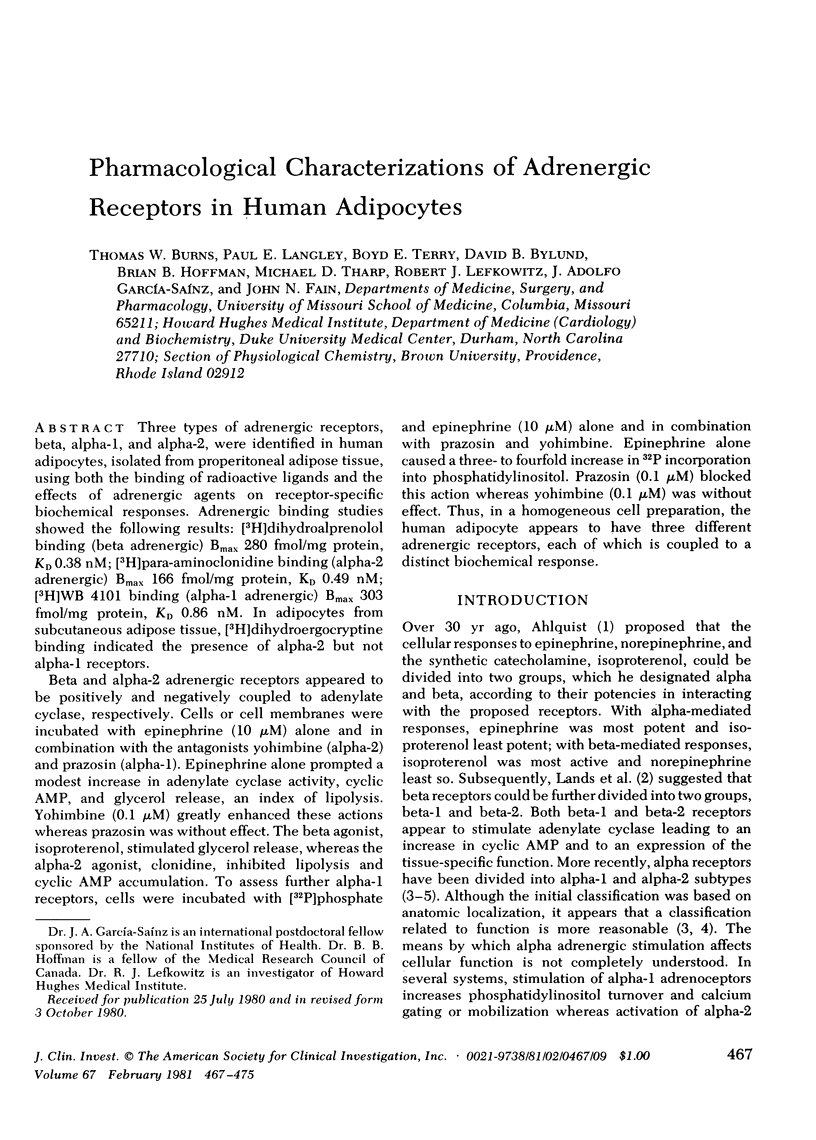
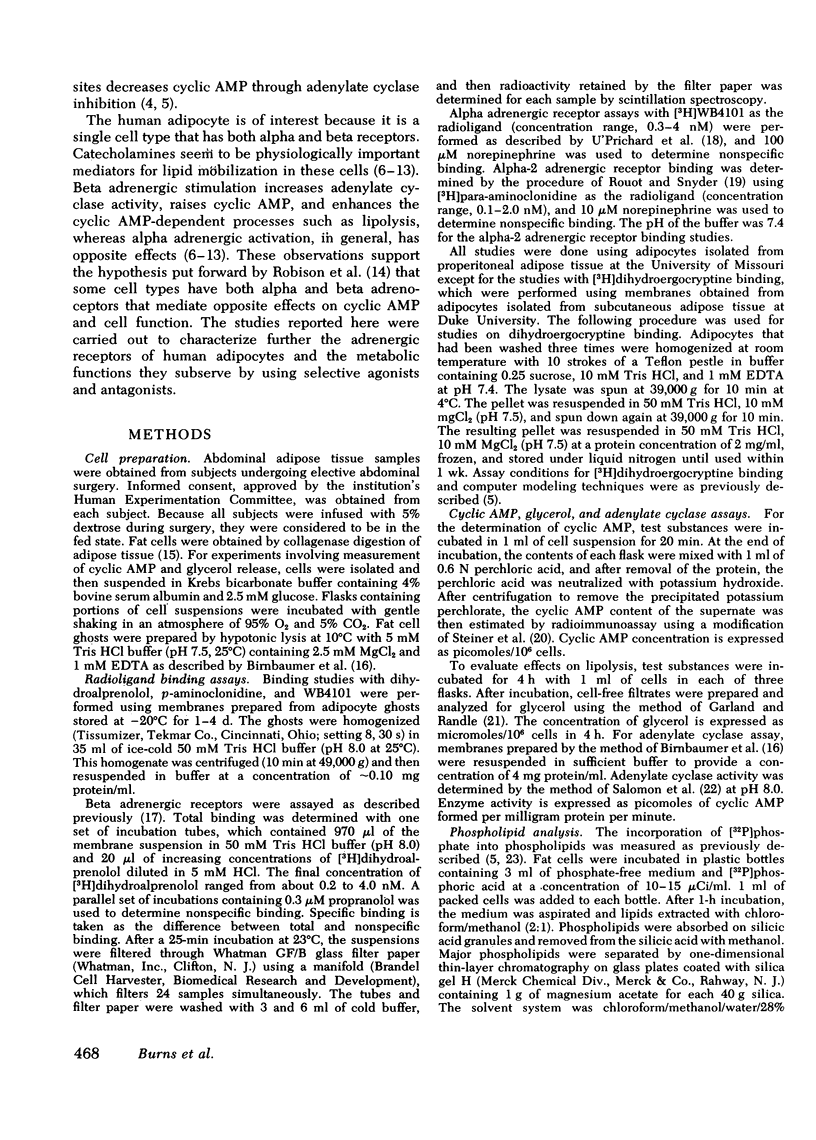
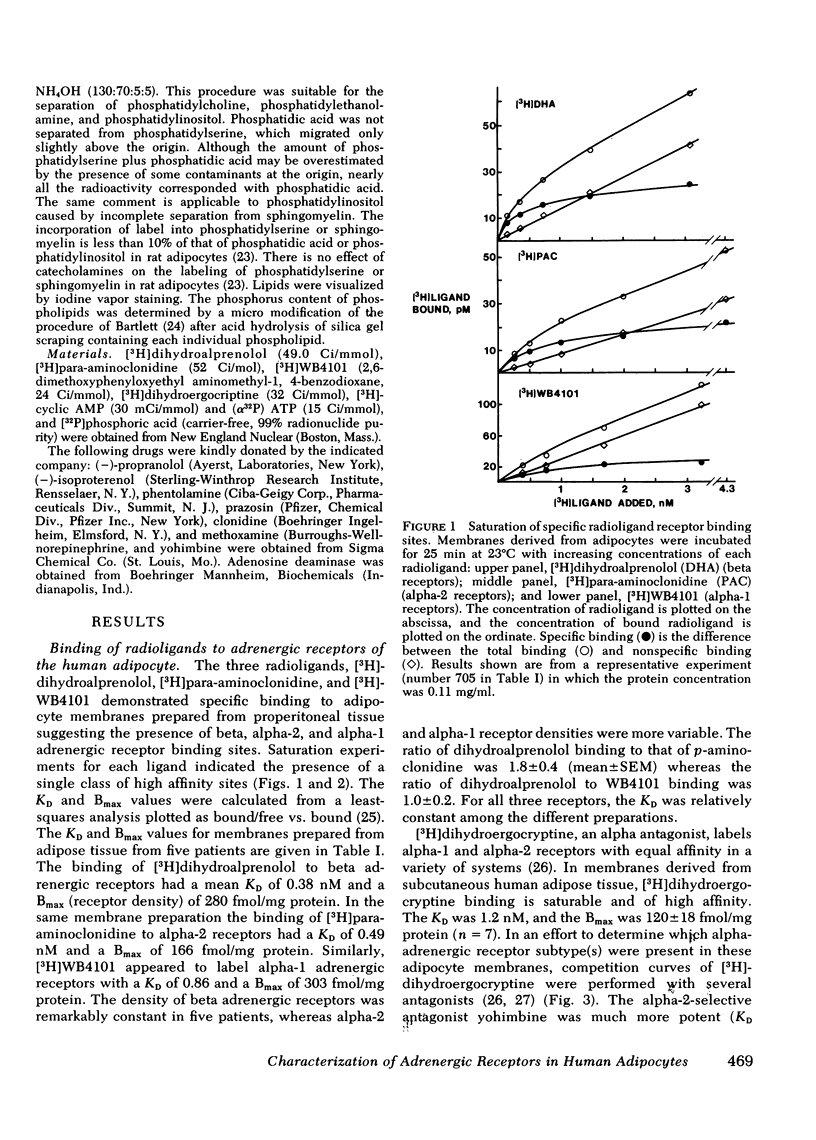
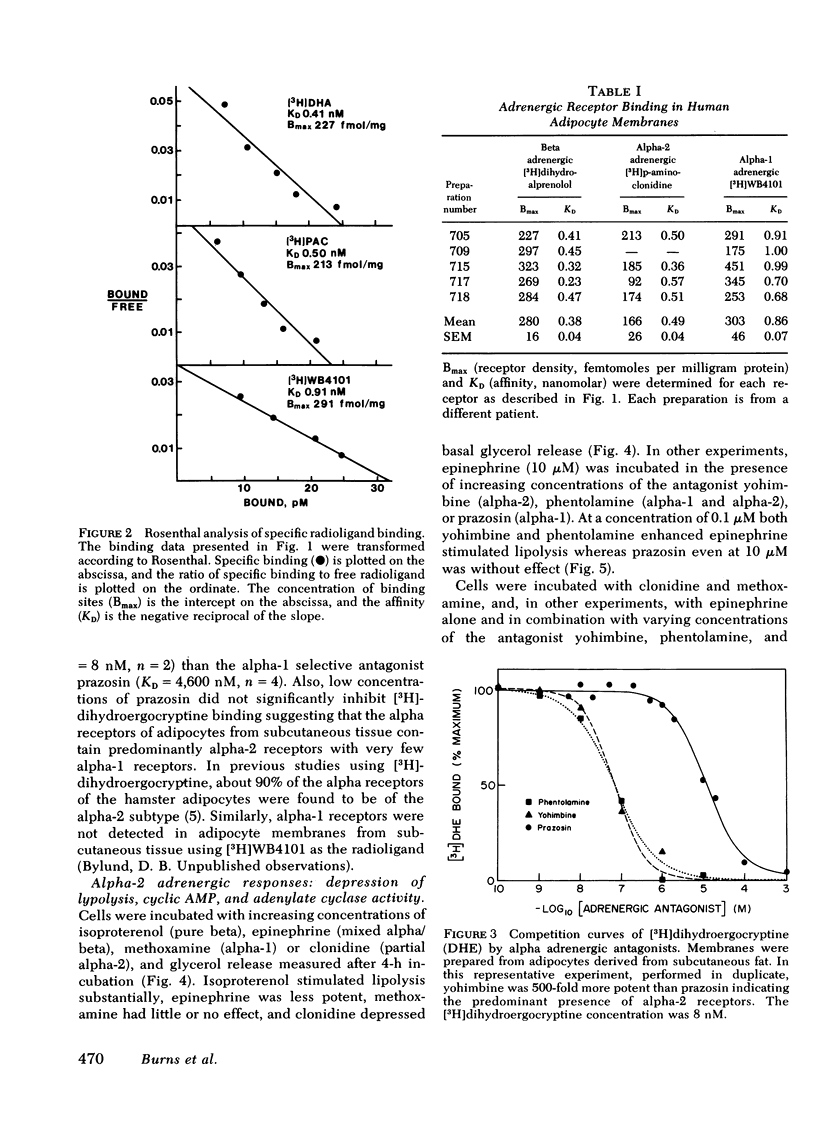
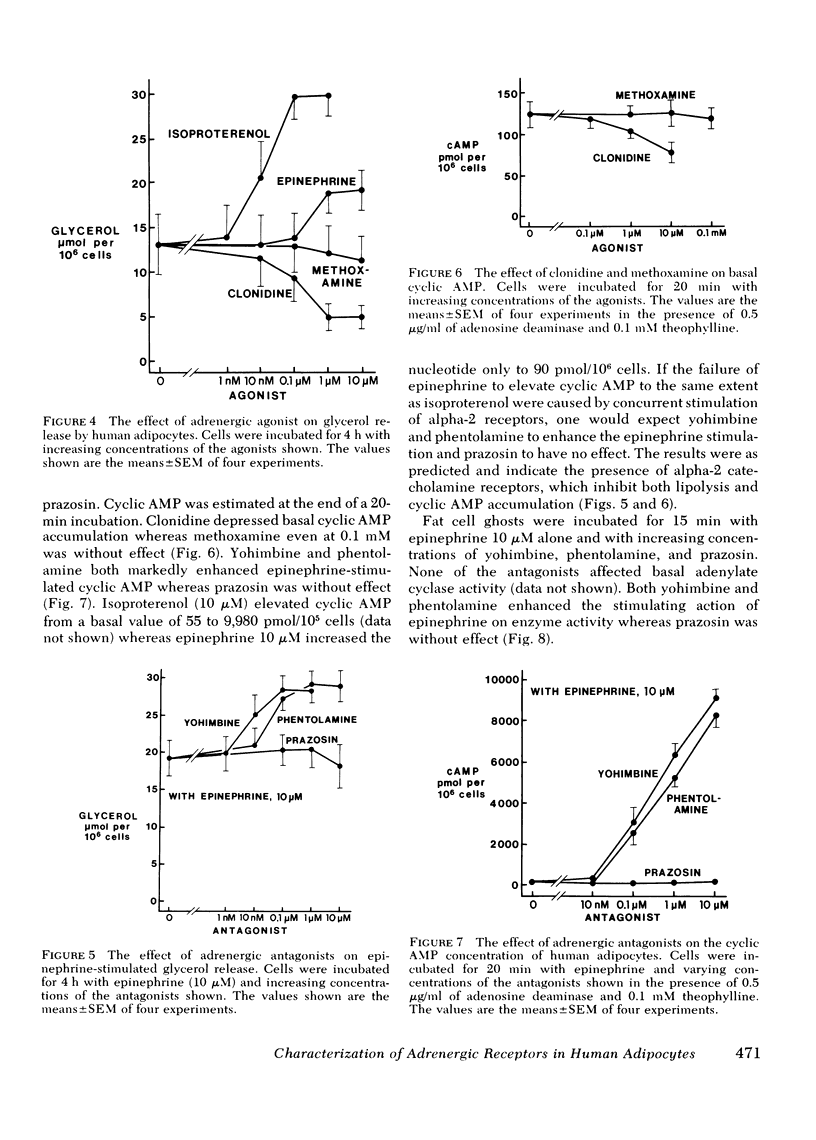
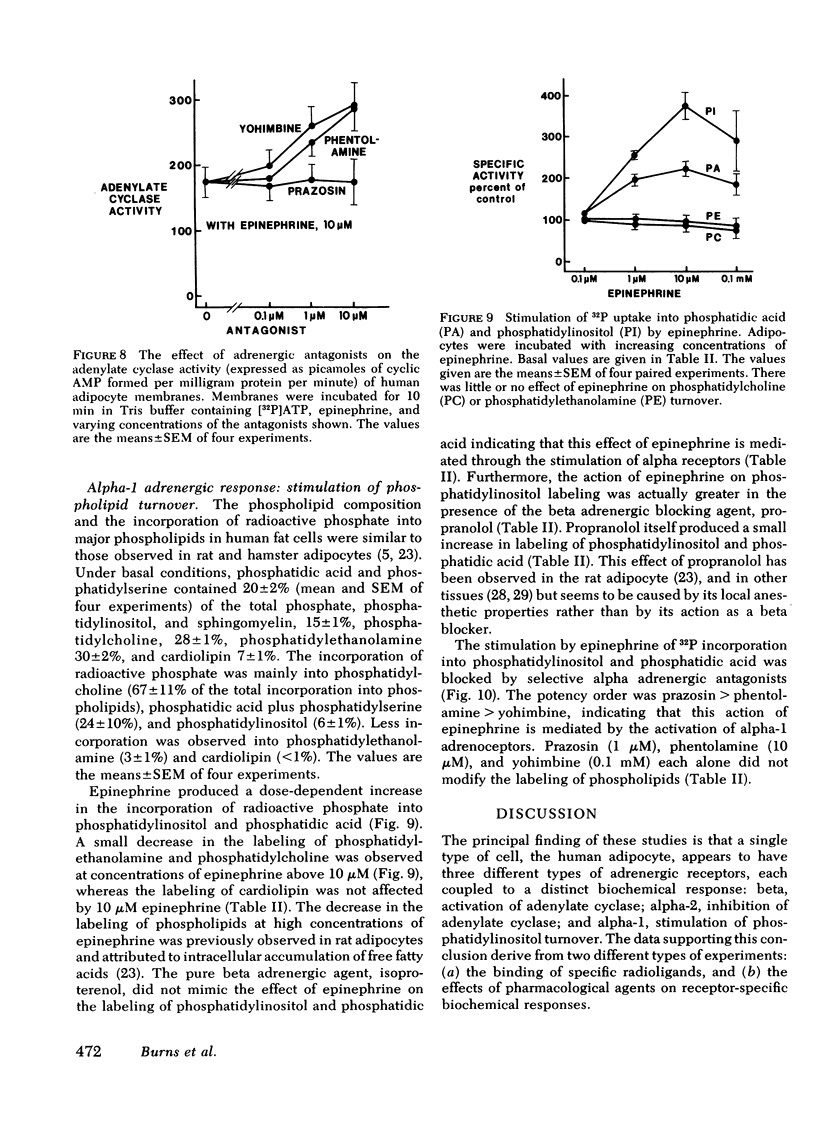
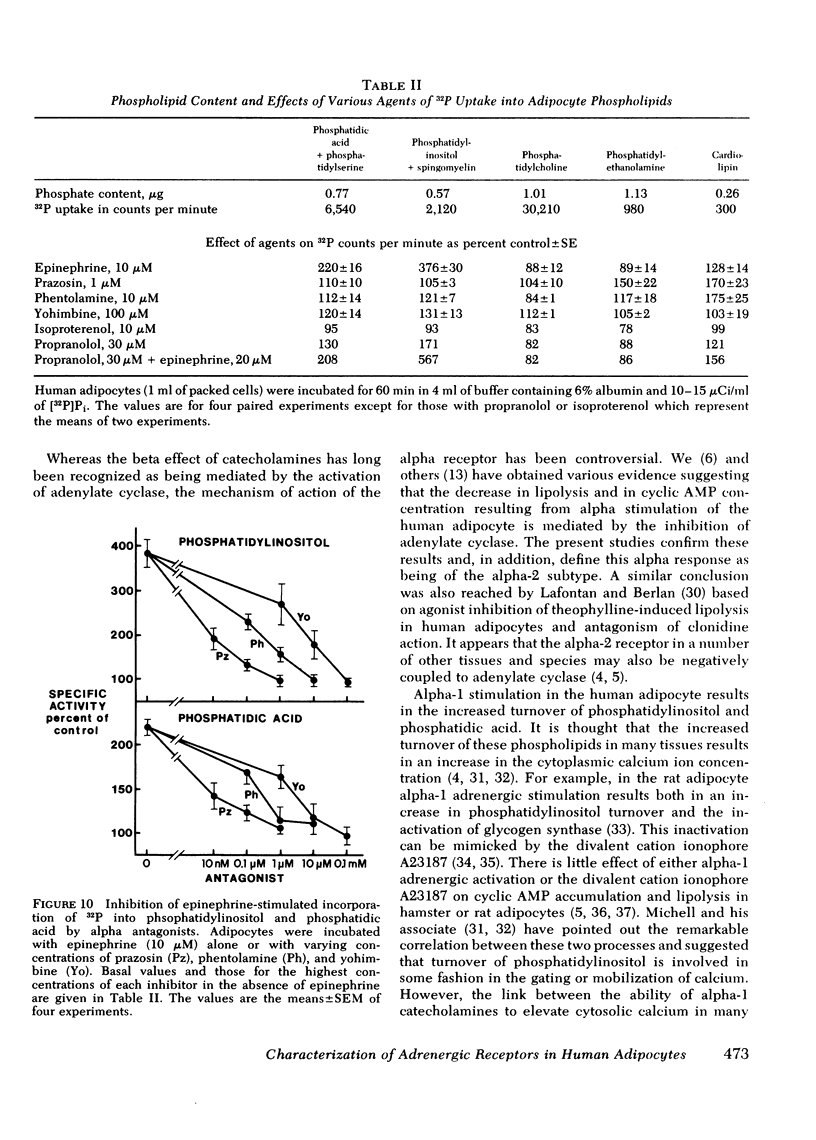
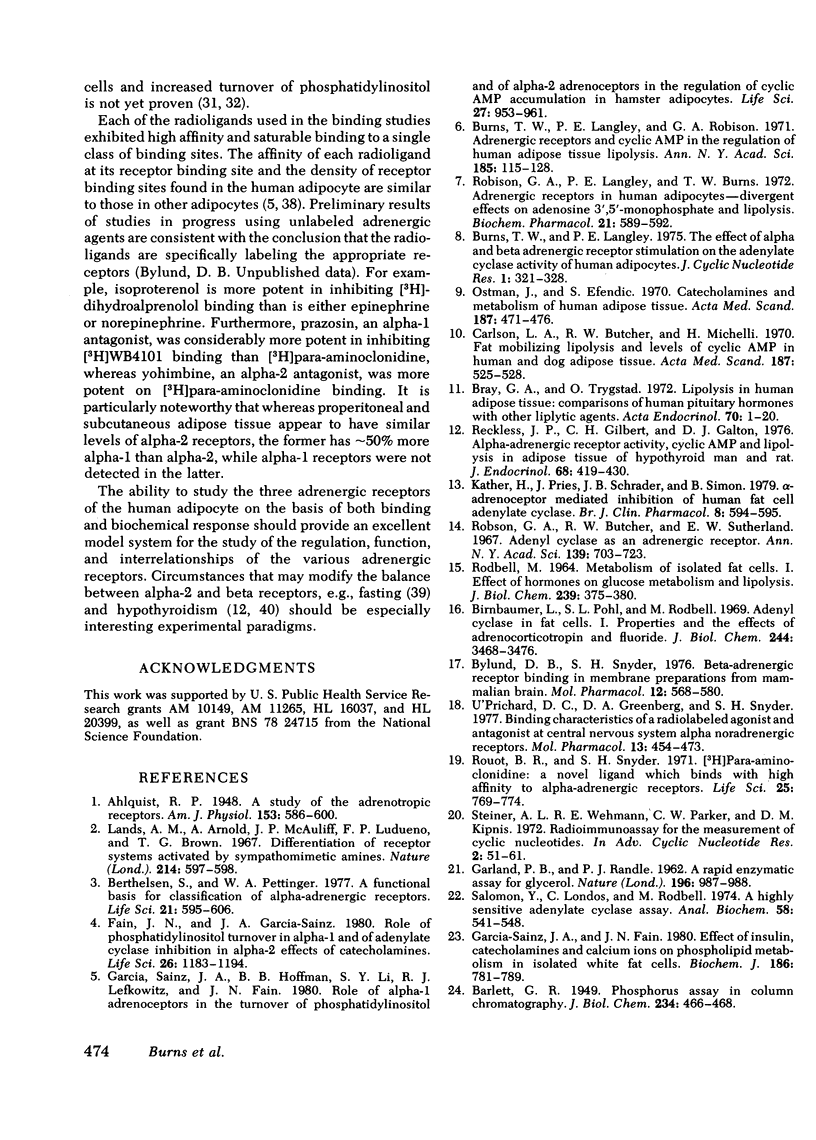
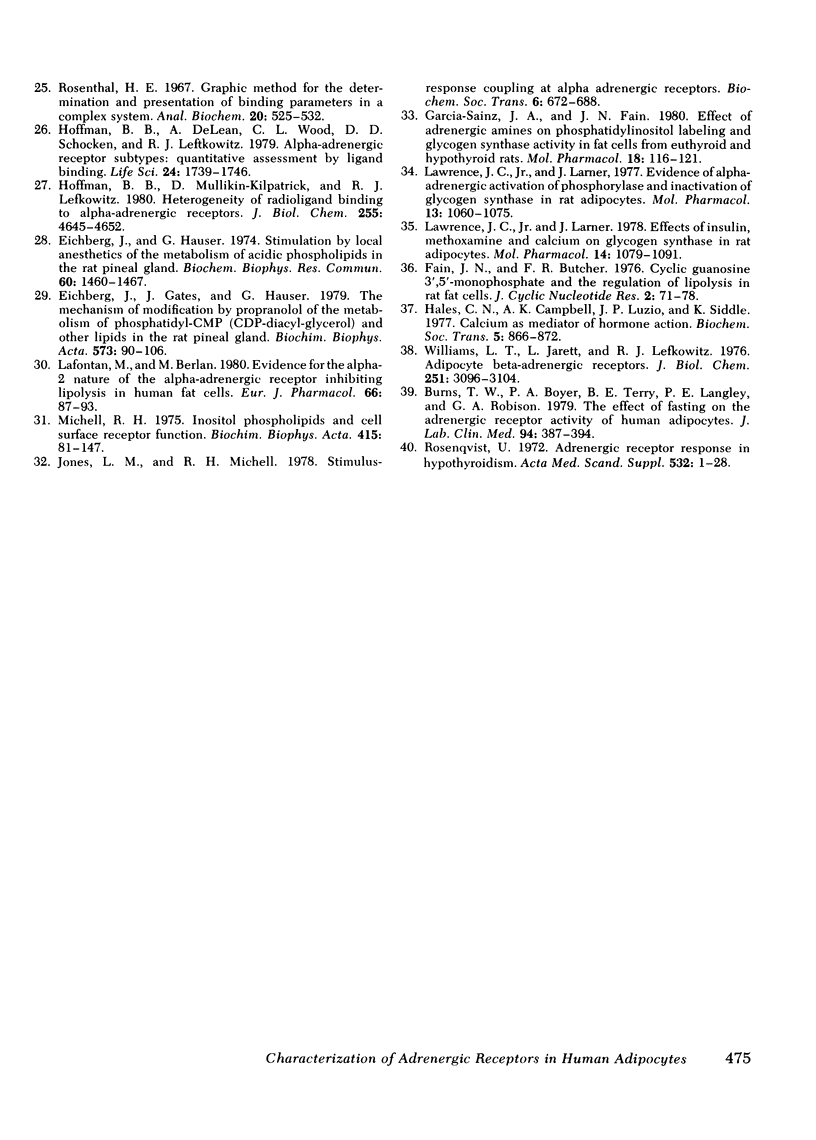
Selected References
These references are in PubMed. This may not be the complete list of references from this article.
- Berthelsen S., Pettinger W. A. A functional basis for classification of alpha-adrenergic receptors. Life Sci. 1977 Sep 1;21(5):595–606. doi: 10.1016/0024-3205(77)90066-2. [DOI] [PubMed] [Google Scholar]
- Birnbaumer L., Pohl S. L., Rodbell M. Adenyl cyclase in fat cells. 1. Properties and the effects of adrenocorticotropin and fluoride. J Biol Chem. 1969 Jul 10;244(13):3468–3476. [PubMed] [Google Scholar]
- Bray G. A., Trygstad O. Lipolysis in human adipose tissue: comparison of human pituitary hormones with other lipolytic agents. Acta Endocrinol (Copenh) 1972 May;70(1):1–20. doi: 10.1530/acta.0.0700001. [DOI] [PubMed] [Google Scholar]
- Burns T. W., Boyer P. A., Terry B. E., Langley P. E., Robison G. A. The effect of fasting on the adrenergic receptor activity of human adipocytes. J Lab Clin Med. 1979 Sep;94(3):387–394. [PubMed] [Google Scholar]
- Burns T. W., Langley P. E., Robison G. A. Adrenergic receptors and cyclic AMP in the regulation of human adipose tissue lipolysis. Ann N Y Acad Sci. 1971 Dec 30;185:115–128. doi: 10.1111/j.1749-6632.1971.tb45242.x. [DOI] [PubMed] [Google Scholar]
- Burns T. W., Langley P. E. The effect of alpha and beta adrenergic receptor stimulation on the adenylate cyclase activity of human adipocytes. J Cyclic Nucleotide Res. 1975;1(5):321–328. [PubMed] [Google Scholar]
- Bylund D. B., Snyder S. H. Beta adrenergic receptor binding in membrane preparations from mammalian brain. Mol Pharmacol. 1976 Jul;12(4):568–580. [PubMed] [Google Scholar]
- Carlson L. A., Butcher R. W., Micheli H. Fat mobilizing lipolysis and levels of cyclic AMP in human and dog adipose tissue. Acta Med Scand. 1970 Jun;187(6):525–528. doi: 10.1111/j.0954-6820.1970.tb02979.x. [DOI] [PubMed] [Google Scholar]
- Eichberg J., Gates J., Hauser G. The mechanism of modification by propranolol of the metabolism of phosphatidyl-CMP (CDP-diacylglycerol) and other lipids in the rat pineal gland. Biochim Biophys Acta. 1979 Apr 27;573(1):90–106. doi: 10.1016/0005-2760(79)90176-0. [DOI] [PubMed] [Google Scholar]
- Eichberg J., Hauser G. Stimulation by local anesthetics of the metabolism of acidic phospholipids in the rat pineal gland. Biochem Biophys Res Commun. 1974 Oct 23;60(4):1460–1467. doi: 10.1016/0006-291x(74)90362-3. [DOI] [PubMed] [Google Scholar]
- Fain J. N., Butcher F. R. Cyclic guanosine 3':5'-monophosphate and the regulation of lipolysis in rat fat cells. J Cyclic Nucleotide Res. 1976;2(2):71–78. [PubMed] [Google Scholar]
- Fain J. N., García-Sáinz J. A. Role of phosphatidylinositol turnover in alpha 1 and of adenylate cyclase inhibition in alpha 2 effects of catecholamines. Life Sci. 1980 Apr 14;26(15):1183–1194. doi: 10.1016/0024-3205(80)90062-4. [DOI] [PubMed] [Google Scholar]
- GARLAND P. B., RANDLE P. J. A rapid enzymatic assay for glycerol. Nature. 1962 Dec 8;196:987–988. doi: 10.1038/196987a0. [DOI] [PubMed] [Google Scholar]
- García-Sáinz J. A., Fain J. N. Effect of insulin, catecholamines and calcium ions on phospholipid metabolism in isolated white fat-cells. Biochem J. 1980 Mar 15;186(3):781–789. doi: 10.1042/bj1860781. [DOI] [PMC free article] [PubMed] [Google Scholar]
- García-Sínz J. A., Hoffman B. B., Li S. Y., Lefkowitz R. J., Fain J. N. Role of alpha 1 adrenoceptors in the turnover of phosphatidylinositol and of alpha 2 adrenoceptors in the regulation of cyclic AMP accumulation in hamster adipocytes. Life Sci. 1980 Sep 15;27(11):953–961. doi: 10.1016/0024-3205(80)90105-8. [DOI] [PubMed] [Google Scholar]
- Hales C. N., Campbell A. K., Luzio J. P., Siddle K. Calcium as a mediator of hormone action [proceedings]. Biochem Soc Trans. 1977;5(4):866–872. doi: 10.1042/bst0050866a. [DOI] [PubMed] [Google Scholar]
- Hoffman B. B., De Lean A., Wood C. L., Schocken D. D., Lefkowitz R. J. Alpha-adrenergic receptor subtypes: quantitative assessment by ligand binding. Life Sci. 1979 May 7;24(19):1739–1745. doi: 10.1016/0024-3205(79)90061-4. [DOI] [PubMed] [Google Scholar]
- Hoffman B. B., Mullikin-Kilpatrick D., Lefkowitz R. J. Heterogeneity of radioligand binding to alpha-adrenergic receptors. Analysis of guanine nucleotide regulation of agonist binding in relation to receptor subtypes. J Biol Chem. 1980 May 25;255(10):4645–4652. [PubMed] [Google Scholar]
- Jones L. M., Michell R. H. Stimulus-response coupling at alpha-adrenergic receptors. Biochem Soc Trans. 1978;6(3):673–688. doi: 10.1042/bst0060673. [DOI] [PubMed] [Google Scholar]
- Kather H., Pries J., Schrader V., Simon B. alpha-adrenoceptor mediated inhibition of human fat cell adenylate cyclase. Br J Clin Pharmacol. 1979 Dec;8(6):594–595. doi: 10.1111/j.1365-2125.1979.tb01051.x. [DOI] [PMC free article] [PubMed] [Google Scholar]
- Lafontan M., Berlan M. Evidence for the alpha 2 nature of the alpha-adrenergic receptor inhibiting lipolysis in human fat cells. Eur J Pharmacol. 1980 Aug 22;66(1):87–93. doi: 10.1016/0014-2999(80)90298-8. [DOI] [PubMed] [Google Scholar]
- Lands A. M., Arnold A., McAuliff J. P., Luduena F. P., Brown T. G., Jr Differentiation of receptor systems activated by sympathomimetic amines. Nature. 1967 May 6;214(5088):597–598. doi: 10.1038/214597a0. [DOI] [PubMed] [Google Scholar]
- Lawrence J. C., Jr, Larner J. Effects of insulin, methoxamine, and calcium on glycogen synthase in rat adipocytes. Mol Pharmacol. 1978 Nov;14(6):1079–1091. [PubMed] [Google Scholar]
- Lawrence J. C., Jr, Larner J. Evidence for alpha adrenergic activation of phosphorylase and inactivation of glycogen synthase in rat adipocytes. Effects of alpha and beta adrenergic agonists and antagonists on glycogen synthase and phosphorylase. Mol Pharmacol. 1977 Nov;13(6):1060–1075. [PubMed] [Google Scholar]
- Michell R. H. Inositol phospholipids and cell surface receptor function. Biochim Biophys Acta. 1975 Mar 25;415(1):81–47. doi: 10.1016/0304-4157(75)90017-9. [DOI] [PubMed] [Google Scholar]
- Ostman J., Efendić S. Catecholamines and metabolism of human adipose tissue. II. Effect of isoprophylnoradrenaline and adrenergic blocking agents on lipolysis in human omental adipose tissue in vitro. Acta Med Scand. 1970 Jun;187(6):471–476. [PubMed] [Google Scholar]
- RODBELL M. METABOLISM OF ISOLATED FAT CELLS. I. EFFECTS OF HORMONES ON GLUCOSE METABOLISM AND LIPOLYSIS. J Biol Chem. 1964 Feb;239:375–380. [PubMed] [Google Scholar]
- Reckless J. P., Gilbert C. H., Galton D. J. Alpha-adrenergic receptor activity, cyclic AMP and lipolysis in adipose tissue of hypothyroid man and rat. J Endocrinol. 1976 Mar;68(3):419–430. doi: 10.1677/joe.0.0680419. [DOI] [PubMed] [Google Scholar]
- Robison G. A., Butcher R. W., Sutherland E. W. Adenyl cyclase as an adrenergic receptor. Ann N Y Acad Sci. 1967 Feb 10;139(3):703–723. doi: 10.1111/j.1749-6632.1967.tb41239.x. [DOI] [PubMed] [Google Scholar]
- Robison G. A., Langley P. E., Burns T. W. Adrenergic receptors in human adipocytes--divergent effects of adenosine 3',5'-monophosphate and lipolysis. Biochem Pharmacol. 1972 Feb 15;21(4):589–592. doi: 10.1016/0006-2952(72)90336-x. [DOI] [PubMed] [Google Scholar]
- Rosenqvist U. Adrenergic receptor response in hypothyroidism. An in vitro study on human adipose tissue and rabbit aorta. Acta Med Scand Suppl. 1972;532:1–28. [PubMed] [Google Scholar]
- Rosenthal H. E. A graphic method for the determination and presentation of binding parameters in a complex system. Anal Biochem. 1967 Sep;20(3):525–532. doi: 10.1016/0003-2697(67)90297-7. [DOI] [PubMed] [Google Scholar]
- Rouot B. R., Snyder S. H. [3H]Para-amino-clonidine: a novel ligand which binds with high affinity to alpha-adrenergic receptors. Life Sci. 1979 Aug 27;25(9):769–774. doi: 10.1016/0024-3205(79)90521-6. [DOI] [PubMed] [Google Scholar]
- Salomon Y., Londos C., Rodbell M. A highly sensitive adenylate cyclase assay. Anal Biochem. 1974 Apr;58(2):541–548. doi: 10.1016/0003-2697(74)90222-x. [DOI] [PubMed] [Google Scholar]
- Steiner A. L., Wehmann R. E., Parker C. W., Kipnis D. M. Radioimmunoassay for the measurement of cyclic nucleotides. Adv Cyclic Nucleotide Res. 1972;2:51–61. [PubMed] [Google Scholar]
- U'Prichard D. C., Greenberg D. A., Snyder S. H. Binding characteristics of a radiolabeled agonist and antagonist at central nervous system alpha noradrenergic receptors. Mol Pharmacol. 1977 May;13(3):454–473. [PubMed] [Google Scholar]
- Williams L. T., Jarett L., Lefkowitz R. J. Adipocyte beta-adrenergic receptors. Identification and subcellular localization by (-)-[3H]dihydroalprenolol binding. J Biol Chem. 1976 May 25;251(10):3096–3104. [PubMed] [Google Scholar]


